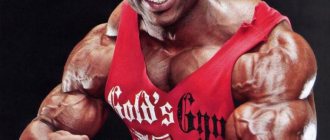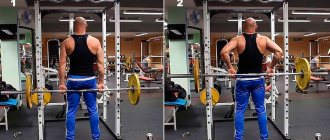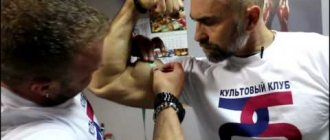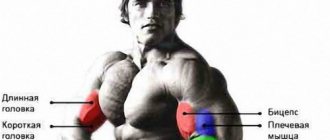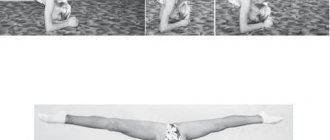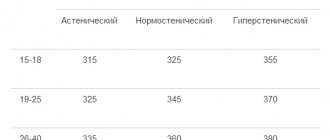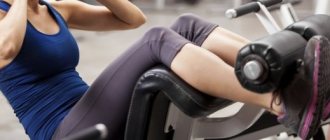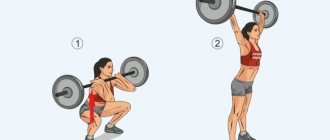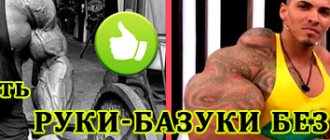BODYBUILDING
(from the English body - body and build - to build) is a sport whose goal is the maximum development of all muscle groups of the athlete and the construction of standard body proportions, which is assessed during competitions (in various weight categories).
The competition is divided into several rounds and includes mandatory and free posing, during which participants (in a group and individually) must demonstrate certain muscle groups from one angle or another: double biceps, triceps, abs, thighs, etc. Judges evaluate the performance of athletes according to several criteria in points, which are then summed up. Also on topic:
FITNESS
Bodybuilding is divided into amateur and professional. Competitions are held separately for men and women, as well as in mixed (and team) categories. Cultivated in many countries. In the USSR, instead of the word “bodybuilding”, concepts such as “bodybuilding” and “athletic gymnastics” were usually used.
What is bodybuilding.
The fundamental idea of bodybuilding is that you can mold anyone into anything. Unlike weightlifting, on the basis of which it originated, in bodybuilding it does not matter how much weight an athlete can “take” (or “squeeze”). The results that are reflected in his appearance are important: equally and proportionally worked muscles (large and small), their volume and relief (ratio of muscles and fat). Bodybuilding competitions cannot be won by an athlete with powerful arms, but skinny legs, or a good back, but a “beer belly.” In fact, bodybuilding is physical education, body culture. Hence another name for this sport: “bodybuilding”.
Also on topic:
MUSCLES
Sports and medicine.
Bodybuilding is a sport “on the verge of medicine”, the development of which directly depends on relevant scientific developments. The regime - proper nutrition, sleep and training schedule - plays no less a role than the training itself. Even an amateur bodybuilder will not be able to achieve noticeable results without carefully counting the calories and proteins he absorbs and without taking special nutritional supplements. These supplements include many nutrients that constantly recovering and growing muscle mass requires: additional proteins, proteins, vitamins, minerals, etc. The formulation of supplements and the pattern of their consumption are developed by specialists; by now, this has essentially become a separate scientific branch .
The most popular problem in bodybuilding is doping
, anabolic steroids and other “chemicals” that cause addiction and destroy the athlete’s body. It is no secret that in many sports, some professionals secretly use doping. But only in bodybuilding, steroids that guarantee maximum results (growth of muscle mass) with a minimum of effort are popular among amateurs. Although famous bodybuilders constantly claim that they achieved their titles without anabolic steroids, few amateur athletes seem to believe them. Doping remains one of the favorite topics for bodybuilding debate. However, the names of some bodybuilding organizations include the word “natural”, which, according to the founders, indicates their freedom from doping. It is also known that the most influential IFBB, the International Federation of Body-Builders (IFBB), received official recognition from the IOC only after it recognized the Anti-Doping Code of the Olympic Movement and introduced an appropriate doping control system.
ALEX TEAM BODYBUILDING TEAM
ALEX TEAM POSITION
ALEX TEAM is a single team of athletes, where there is no place for the names of clubs, division by age and number of titles won.
ALEX TEAM is a TEAM united by a common goal - VICTORY over rivals, VICTORY over yourself! Welcome to the TEAM! 1.0 Regulations on the provision of benefits for ALEX TEAM athletes
Who is this position for?
- For holders of “Pro” contracts ALEX FITNESS and CCK OLYMP,
- For all visitors of ALEX FITNESS and OLYMP clubs, as well as visitors of other fitness clubs,
- For professional trainers open to cooperation,
- In order to support our employees who have never competed in professional competitions, but with our support are capable of doing so!
1. For holders of the “Pro” agreement in SFK Alex Fitness and CCK OLYMP
- The holder of the “Pro” agreement can receive a discount on the payment of the specified agreement in the case of representing the club/network at external sports competitions as part of the ALEX TEAM team, or, if team leadership is not supported by the competition regulations, by participating in the individual competition and taking prizes.
- When an athlete participates in commercial tournaments, no benefits are provided.
- Benefits for athletes are provided in accordance with Appendix 1.1 to this regulation. The benefit is provided in the month following the previous competition.
- The benefit according to the application is provided once.
- When an athlete performs at the same competition in several nominations/categories, benefits are not summed up, but are determined based on the athlete’s best result.
- When an athlete performs in different competitions specified in the regulations, the benefits are summed up.
- As part of participation in ALEX TEAM with the participation of an athlete, photo sessions and video filming may be provided. At the same time, the athlete is guaranteed the provision of all materials filmed by SFK ALEX FITNESS with his participation for personal use.
Appendix 1.1. Benefits for holders of the “Profi” agreement in SFK ALEX FITNESS and CCK OLYMP.
| Kind of sport | Federation | Competitions | The best result of an athlete | Benefit provided |
| Bodybuilding, classic bb, fitness, body fitness, bikini, beach bb | IFBB | Arnold Classic, Olympia | participation in the finals (1-6 places) | 100% discount |
| European and World Championships, Russian Championships and Cups | prizes (from 1st to 3rd), as well as victory in the absolute category | 100% discount | ||
| City and regional, regional competitions | first place or absolute victory | 100% discount | ||
| 2nd or 3rd place in a category | 50% discount | |||
| participation in the top 10 national team leaders* | discount in the amount of the entry fee | |||
| participation in the team | branded T-shirt | |||
| Powerlifting | IPF | World Championship | 1 place | 100% discount |
| WPC/AWPC | World Championship (assessment by result) | 1 place | 50% discount | 50% discount |
| Bench press | IPF | World Championship | 1 place | |
| WPC/AWPC | World Championship (assessment by result) | 1 place | 30% discount | |
| Weightlifting | FTAR | City and regional | 1-3 place | 50% discount |
| Russian Championships and Cups | finals, prizes | 50% discount | ||
| European and World Championships | finals, prizes | 50% discount | ||
| *by decision of the head coach of the national team, if such a position is provided for by the scope of the national team | ||||
| Multifunctional training competition, CrossFit | Official competitions | Grand Cup, Siberian Showdown, Heraklion Cup, Ural Athletic Challenge | reaching the final | 100% discount |
| participation | 40% discount | |||
| Reebok CrossFit (RCF Games) | reaching the final | 100% discount two months in a row | ||
| participation | 100% discount | |||
| Crossfit Games Regions | 1-5 places in the final (all categories) | 100% discount | ||
| participation | 50% discount | |||
| City and regional, regional competitions, participation in Crossfit Games The Open | 1-5 places in the final (all categories) | 20% discount | ||
| participation | 10% discount | |||
2. For members and non-members of ALEX FITNESS and CCK OLYMP clubs
- A club member, as well as an athlete who does not have a valid subscription to SFK ALEX FITNESS and CCK OLYMP, can receive a gift certificate for representing the club/network at external sports competitions as part of the ALEX TEAM team or representing ALEX TEAM in the individual competition, if this is provided for by the competition rules.
- Gifts for athletes are provided in accordance with Appendix 1.2 of these regulations.
- The gift is provided to the athlete once.
- If the gift implies an extension, then it is sold in the club where the athlete already has an active subscription.
- If the gift does not imply an extension, then the athlete can choose a club from among the clubs of the SFK ALEX FITNESS network.
- In case of victory in several competitions during the season, the duration of gift passes is not cumulative; the gift from the date of the last competition will be valid.
- Gift membership or renewal cannot be assigned.
- As part of participation in ALEX TEAM with the participation of an athlete, photo sessions and video filming may be provided. At the same time, the athlete is guaranteed the provision of all materials filmed by SFK ALEX FITNESS with his participation for personal use.
Appendix 1.2. Benefits for members and non-members of the clubs SFK ALEX FITNESS and CCK OLYMP.
| Kind of sport | Federation | Competitions | The best result of an athlete | Promotion | |
| For a club member | For non-club members | ||||
| Bodybuilding, fitness, body fitness, classic bb, bikini, beach bb | IFBB | Arnold Classic, Olympia | participation in the finals (1-6 places) | Extension 1 year | Subscription 1 year |
| European and World Championships, Russian Championships and Cups | prize places (from 1st to 3rd) | Extension 1 year | Subscription 1 year | ||
| City and regional, regional competitions | First place | ½ year extension | ½ year subscription | ||
| prizes 2nd and 3rd places in categories | ½ year extension | ½ year subscription | |||
| participation in the top 10 national team leaders* | ½ year extension | ½ year subscription | |||
| participation in the team | branded T-shirt, extension 3 months. | branded T-shirt and 2 month subscription. | |||
| Powerlifting | IPF WPC/AWPC | World Championship | 1 place | Extension 1 year | Subscription 1 year |
| Russian championship | 1 place | Extension 3 months | Subscription 3 months | ||
| World Championship (score by result) | 1 place | ½ year extension | ½ year subscription | ||
| Russian Championship (score based on results) | 1 place | Extension 2 months | Subscription 2 months | Extension 3 months | Subscription 3 months |
| Bench press | IPF | World Championship | |||
| WPC/AWPC | World Championship | 1 place | Extension 1 month | Subscription 1 month | |
| Weightlifting | FTAR | City and regional | 1-3 place | Extension 1 month | Subscription 1 month |
| Russian Championships and Cups | finals, prizes | Extension 3 months | Subscription 3 months | ||
| European and World Championships | finals, prizes | ½ year extension | ½ year subscription | ||
| *by decision of the head coach of the national team, if such a position is provided for by the scope of the national team | |||||
| Multifunctional training competition, CrossFit | Official competitions | Grand Cup, Siberian Showdown, Heraklion Cup, Ural Athletic Challenge | reaching the final | Extension 1 year | ½ year subscription |
| participation | Extension 3 months | Subscription 3 months | |||
| Reebok CrossFit (RCF Games) | reaching the final | Extension 1 year | ½ year subscription | ||
| participation | ½ year extension | Subscription 3 months | |||
| Crossfit Games Regions | 1-5 places in the final (all categories) | ½ year extension | ½ year subscription | ||
| participation | Extension 3 months | Subscription 3 months | |||
| City and regional, regional competitions, participation in Crossfit Games The Open | 1-5 places in the final (all categories) | Extension 3 months | Subscription 2 months | ||
| participation | Extension 1 month | Subscription 1 month | |||
3. For employees of the ALEX FITNESS and CCK OLYMP clubs who are not related to sports by occupation (club managers, sales department employees, reception staff, etc.)
- Any employee of ALEX FITNESS and CCK OLYMP, who is not a professional athlete, and also by occupation not related to coaching, for representing a club/network in any of the mentioned disciplines for the first time at external sports competitions as part of the ALEX TEAM team or representing ALEX TEAM in in the personal competition, if provided for by the rules of the competition, he may receive a monetary reward, the amount of which is indicated in Appendix 1.3 to these Regulations.
- When an athlete performs at the same competition in several nominations/categories, rewards are not summed up, but are determined based on the athlete’s best result.
- When an athlete performs in different competitions specified in the regulations, the bonuses are summed up.
Appendix 1.3. Rewards for employees of the ALEX FITNESS and CCK OLYMP clubs who are not related to sports by occupation.
| Kind of sport | Federation | Competitions | The best result of an athlete | Promotion |
| Bodybuilding, fitness, body fitness, classic bb, bikini, beach bb | IFBB | City and regional, regional competitions | 1-3 places | Reward in the amount of 20,000 rubles. |
| final in the top six | Reward in the amount of 10,000 rubles. | |||
| participation in the team | branded T-shirt, reward in the amount of RUB 5,000. | |||
| Powerlifting | IPF | Russian championship | top five final | Reward in the amount of 10,000 rubles. |
| WPC/AWPC | Russian Championship (score based on results) | |||
| Bench press | WPC/AWPC | Russian championship | final in the top five | Reward in the amount of 10,000 rubles. |
| Weightlifting | FTAR | City and regional | final in the top five, provided that you have not previously competed in this sport | reward in the amount of 5,000 rubles. |
2.0 Cooperation with athletes and coaching associations not provided for by this provision.
Cooperation with coaches and organizations wishing to organize the participation of athletes trained by them as part of the ALEX TEAM in competitions provided for in one of the appendices of these Regulations is negotiated on an individual basis. We are open and happy to cooperate!
3.0 Position Adjustments
The regulations may be revised regarding benefits and gifts and brought to the attention of athletes by publication on the ALEX TEAM website.
Bodybuilder training.
Many people mistakenly imagine bodybuilding solely as a system of exercises with weights, i.e. special exercise equipment and free weights: kettlebells, barbells, dumbbells. In other words, we mean only power, moderately static anaerobic
exercises.
In fact, aerobic
exercise (aerobics, running, martial arts, skiing, tennis, all kinds of moving exercises without weights aimed at developing endurance and associated with increased heart rate and fat burning) are no less important in bodybuilding. Anaerobic exercise allows you to increase weight, and aerobic exercise allows you to create relief, “dry” muscles, and make the body a kind of visual aid to anatomy.
It is worth noting that bodybuilders look exceptionally sculpted - with every tiny muscle and vein on display - only during competitions. They go on strict diets, train in rubber suits, dehydrate the body with diuretics - all this in order to dry out the accumulated mass. Moreover, if doping control detects diuretics in the athlete’s blood, he will be disqualified - in accordance with the IFBB directive (corresponding restrictions apply in other bodybuilding associations, but the lists of drugs prohibited for use and the doping control systems adopted in various organizations have some differences) . True, diuretics are not only chemical, and any doping control has loopholes. The hardest time is for bodybuilders who ignored aerobics, gained weight, but did not achieve endurance. They are not able to easily burn fat, and therefore they focus on fasting and the mentioned diuretics, losing muscle mass and health with fat and water.
A bodybuilder gains muscle mass through weight training, exposing his body to deliberate stress loads. Training is built in accordance with two fundamental principles. The first is the principle of isolation
, to which the simulators best correspond.
The simulator only works the muscle being trained (muscle group), the rest of the body does not get tired unnecessarily, and the bodybuilder can control the load and progress of a specific muscle. If he trained all the muscles at the same time, as in aerobics, he would not be able to accurately assess which of them was really tired, and how to load the one that was not working enough yet. The second principle is the principle of “shocking” the muscles
. The loads should constantly increase, and the muscles should be completely exhausted during each workout. During recovery and sleep, muscles grow to accommodate the increased workload. If an athlete gets enough sleep, supplies the body with vitamins and proteins to build muscles, his physical parameters will steadily progress.
The origins of bodybuilding. Eugene Sandow (1867–1925).
The first serious training programs were developed by the generally recognized pioneer of modern bodybuilding, a native of Germany, Eugene Sandow (real name - Friedrich Wilhelm Müller). A figurine with his image is the most honorable award in modern professional bodybuilding; it is received by the winners of the Mr.
Olympia
.
Like his colleagues, Sandow began his career by demonstrating strength tricks. He soon realized that his personal achievements were not limited to the mere weight of the weights he lifted: he managed to develop powerful, harmonious muscles worthy of the envy of the ancient Greek. Sandow based his new show on a demonstration of muscles, during which he imitated the poses of ancient sculptures (thus laying the foundations for bodybuilding posing
). With this show, the athlete traveled all over Europe and America.
In England, over time, he created a whole network of athletic clubs and began publishing a specialized magazine. And in the fall of 1901 he held the first ever organized bodybuilding tournament in London. Sandow's authority was so high that he was appointed to the position of personal trainer to the English King George V (ruled 1910–1936). While in this position, Sandow did a lot to increase government funding and develop sports. He also published his training programs and published study guides.
His brilliant career was cut short in the 1920s, according to the official version, due to a stroke. Sandow allegedly followed the lead of the crowd of onlookers who witnessed the road accident and agreed to the offer to pull the car that had landed there out of the ditch with one hand: overexertion caused a cerebral hemorrhage.
Legendary athlete sculpture
We will leaf through the pages of Sandow’s biography without much interest, lingering only on some facts that will help reveal the secret of the strongest man in the world. Real name: Friedrich Müller. He was born in Königsberg, present-day Kaliningrad. The father was a Prussian German, and the mother was Russian. As a child, he was a sickly child, but he dreamed of being strong and healthy, he was interested in anatomy and physical education, which helped him realize that strength can be acquired.
And Müller is making amazing progress. Having later moved to England, he takes a pseudonym - Eugene Sandow, or, in the English manner, Eugene Sandow. The abilities are amazing: 200 push-ups from the floor within four minutes, holding 27 kilogram weights with outstretched arms, backflip with weights landing in the place from which the trick began, holding a platform with three horses on the chest. Of course, if you look at all this through the prism of time, then stunts may not seem such an amazing demonstration of strength, but at the time of Sandow’s performances, at the end of the 19th century, when among wealthy people, reading and laughter, showers with rubbing and leisurely walking... it was something truly amazing.
In England, Sandow is noticed by the sculptor Frederick Pomeroy and invites the athlete to become a model for his sculpture, which is destined to become legendary: the figure of a strongman with broad shoulders, chiseled abs and strong arms holding one end of the barbell has forever entered the history of bodybuilding. Sandov liked Pomeroy’s work, but he was not the only one, so many copies were created, which were distributed to private collections and schools of strength and beauty of the body...
Sandow depicts the sculpture of the Dying Gaul, symbolizing the Greek ideal of beauty
The Wider brothers and the bodybuilding industry.
If Eugene Sandow is rightfully considered the “grandfather” of bodybuilding, then Joe Weider (the legendary trainer of champions, who in 1946, together with his brother Ben, created the IFBB, which already includes 177 countries, and who invented the most prestigious competition among professional bodybuilders - “Mr. Olympia” ) is called nothing less than the “father” of this sport.
The Widers did not create the industry from scratch - it existed before: with its own training manuals, specialized magazines, competitions and training halls. But it was the Wider brothers who raised this sport to a fundamentally new level. And it was they who lured the future legendary Terminator (and now governor) to America - the Austrian Arnold Schwarzenegger, who over time managed to win seven gold Sandow statuettes and became perhaps the most iconic figure in the history of world bodybuilding.
General information and the essence of bodybuilding
Any gym goer is engaged in building a body, which is the essence of bodybuilding. Even if he does not perform on stage, does not learn to pose and does not strive to compete in the aesthetics of the body, he is a lover of bodybuilding if he uses the classic techniques of this sport:
- Weider's Principles for Building Muscle.
- A combination of strength training, diet and cardio to achieve a specific appearance.
- Goal setting in the spirit of body correction, rather than setting goals for strength, speed or agility.
At the same time, fitness methodologists are trying in every possible way to distance themselves from bodybuilding due to its “unhealthy” reputation. Yes, to increase super volumes, bodybuilders use pharmacological drugs, which in sports are regarded as doping. Almost no bodybuilding federation has a sufficiently high-quality doping testing system. And somehow monitoring this and not allowing “unnatural” athletes is irrational, since this will lead to a decrease in the entertainment value of the competitions and the income from their organization. And even those who talk about “natural” training often use steroids and are simply lying.
Professional bodybuilding.
According to some reports, there are now about 200 professional bodybuilders around the world. They have the appropriate “professional cards” (to obtain it you must win a competition of international significance) and are maintained by a federation, i.e. earn money by training and competing in various competitions - regardless of whether they win the main prize.
The competitions are strictly regulated. For example, according to the IFBB rules, only professionals who are a prerequisite can participate in the Mr. Olympia competition! - members of the Federation. However, they do not have the right to participate in competitions organized by other federations and associations. (These rules were introduced back in the days of Schwarzenegger, who, being a practical man and dependent on the Wider organization, preferred Olympia to further participation in the Mr. Universe competitions, in which he had previously won several victories.)
Under the auspices of the IFBB, competitions are held among professionals in the categories: bodybuilding (male and female), fitness (women) and body fitness (women), based on the results of which candidates for participation in the competitions “Mr. Olympia”, “Miss Olympia”, “ Fitness Olympia" and "Body Fitness Olympia". In addition to the Olympia, the Arnold Classic (men's), Miss International (women's bodybuilding), Miss Fitness International and Figure International competitions, held annually by Schwarzenegger and boasting a substantial amount of prize money, are particularly popular, as well as tournaments “Night of Champions” and “Mr. Olympia for Veterans,” which involves athletes over 40 years of age. (The official IFBB calendar also includes the men’s “Russian Grand Prix” tournament.)
It is characteristic that the very division into professionals and amateurs sometimes turns out to be very arbitrary. For example, the IFBB organizes competitions among amateurs, including European and world championships (bodybuilding is also included in the program of the World Games), and the Mr. Universe competition, conducted by the amateur association, by definition, NABBA, has not only an amateur, but also a professional category of awards .
Types of bodybuilding
Today bodybuilding is divided globally into:
- amateur;
- professional.
Amateurs compete in tournaments ranging from the club championship to the world championship, investing their own money in preparation. As a rule, they do not receive any significant bonuses for winning, although recently the prize money at tournaments at the national championship level has become larger.
You can become a bodybuilding professional by winning a qualifying tournament and receiving the so-called Pro Card. Professionals receive the right to compete in large commercial tournaments with cash prizes (including the Arnold Classic and Mr. Olympia), but their main source of income is contracts with sports nutrition companies, clothing brands, and payments for filming in magazines.
Federation
Currently, the most popular bodybuilding federations are:
- The IFBB is an international federation that holds tournaments, including the Olympia in Las Vegas, USA. In Russia, her interests are represented by the Russian Bodybuilding Federation (RFB).
- WBFF is also an organization with international status, but is smaller. But the show element is more developed there. In women's categories, for example, various fantasy costumes are allowed, and it is mandatory to wear dresses.
- NABBA is more similar to the IFBB in nominations and categories, but does not have such a large and famous tournament as Mr. Olympia.
- NBC is the new Russian Federation of Modern Bodybuilding and Fitness. NBC is distinguished by the presence of a separate nomination for posing, open judging, large prizes and compensation for trips to international tournaments, competitions among beginners and Paralympians.
Next, we will consider the disciplines on the basis of which bodybuilding competitions are held. Each federation may have its own additional categories, so we will only focus on the most popular ones.
© Augustas Cetkauskas — stock.adobe.com
Men's disciplines
These include:
- bodybuilding men;
- Men's Physique, or beach bodybuilding;
- classic bodybuilding.
Bodybuilding men
Men compete in age categories:
- Guys under 23 years old can compete as juniors.
- For athletes over 40 years old, there are veteran categories: 40-49 years old, 50-59 years old, over 60 years old (only for international competitions, at the national level and below for veterans there is only one category - over 40).
- Athletes of all ages can compete in the general category.
To further break down all participants, weight categories are applied:
- For juniors this is up to and over 80 kg (at international competitions - 75 kg).
- For veterans at international competitions in the 40-49 year old category - up to 70, 80, 90 and over 90 kg. For 50-59 years old – up to and over 80 kg. Over 60 in international competitions and over 40 in smaller competitions – one absolute category.
- In the general category: up to 70, 75 and in increments of 5 kg up to 100, as well as over 100 kg.
The judges evaluate the volume of muscle mass, harmonious physique, symmetry, degree of dryness, general aesthetics and body proportions, and free program.
Classic bodybuilding
Male bodybuilding over 100 kg are “mass monsters”, often having nothing in common with ordinary gym-goers and tournament spectators. However, it is their competitions that are the most spectacular (you can remember the same “Olympia”). The discipline of mens physics has recently become more popular among participants. But fans of this sport do not like this category for the lack of working out the leg muscles and the general image. A lot of people don't like guys who do their hair and put on eye makeup before going on stage.
Classic male bodybuilding is a compromise between mass monsters and beachgoers. Proportional athletes who are closer to the standards of the “Golden Era” of bodybuilding compete here. Often the “classics” are former beach bodybuilders who have gained more mass and worked their legs.
IFBB classics use height categories, and based on height, the maximum weight of participants is calculated:
- in the category up to 170 cm (inclusive) maximum weight = height – 100 (+ an excess of 2 kg is allowed);
- up to 175 cm, weight = height – 100 (+4 kg);
- up to 180 cm, weight = height – 100 (+6 kg);
- up to 190 cm, weight = height – 100 (+8 kg);
- up to 198 cm, weight = height – 100 (+9 kg);
- over 198 cm, weight = height – 100 (+10 kg).
There are also junior and veteran categories.
Men's Physique
Mens physics, or beach bodybuilding, as it is called in Russia, was originally invented to popularize bodybuilding. Time passed, young people left to do CrossFit, no one wanted to be like the monsters of the masses. The average gym goer wanted to look a little more toned than the male underwear model. Therefore, the IFBB took drastic measures - in 2012 they gave access to the stage to those who look a little more muscular than high fashion models.
Mens physicists go on stage in beach shorts; they are not required to work their legs. The nomination evaluates shoulder-waist proportions, stage presence and posing skills. Excessive massiveness is not welcome. That is why this type of bodybuilding can be considered the most suitable for beginners, and only then you can build up mass, move on to the classics or heavy categories.
Many bodybuilders were against this discipline precisely because of the shorts. Still, building distinct legs is an entire art, and now anyone who has just been in the “rocking chair” for a couple of years and is gifted with good genetics can perform.
The principle of division into categories is similar to the classics - height categories and calculation of maximum weight.
Women's disciplines
Bodybuilding women (Women Physique)
What is women's bodybuilding? These are also monsters of the masses, only girls. During the “Golden Era,” girls appeared on stage who were more reminiscent of modern fitness bikinis or body fitness and wellness athletes. But later, masculine ladies appeared, performing with a mass that would be the envy of an experienced visitor to a rocking chair, tough “dryness” and separation.
It is clear that it is impossible to squeeze all this out of an ordinary female body, and girls use steroids. To accept or not is everyone’s choice, but public opinion has turned against girls, not boys. The peak of popularity of women's bodybuilding in the classic form occurred in the 80s. Then the IFBB gradually began to introduce new disciplines to give the opportunity to perform for those who do not want to get too involved in pharmacology.
The category of women’s bodybuilding itself was renamed Women Physique in 2013 and they began to focus on less muscle mass, however, to me, this discipline is still the most “muscular” of all women’s ones. There is a division according to height - up to and over 163 cm.
Bodyfitness
Body fitness is the first answer to the overly muscular and masculine girls on stage. Formed in 2002. Initially, this discipline required a wide back, a narrow waist, well-developed shoulders, dry abs and fairly expressive legs.
But from year to year the requirements change, and girls either become “large”, on the verge of a woman physicist, or thin, without volume and “dried out”. In this category, the standards are closest to fitness, but do not require an acrobatic free program. Before the advent of the bikini, this was the most accessible female discipline.
The rules here also provide for height categories - up to 158, 163, 168 and over 168 cm.
Fitness
Fitness is precisely the athletic direction for which those who do not consider posing on stage to be sporting are interested in sports. Here you need to present a gymnastics program or dance. Acrobatic elements of fitnessists are complex, they require gymnastic training, and the requirements for form are quite high. This sport is best suited for those who did rhythmic gymnastics as a child. But many achieve heights in it, even without such preparation.
The judges evaluate both the form of the athletes separately, within the framework of posing, and the complexity and beauty of the free program. Our most famous athlete in the fitness category is a Russian woman living in the USA, Oksana Grishina.
Fitness bikini
Fitness bikini and its spin-offs, Wellness and Fit-Model, have become “the salvation of the average person from female bodybuilders.” It was the bikini that attracted ordinary women to the gyms and gave rise to the fashion for pumping up the buttocks and minimally working out the rest of the body.
In a bikini you don’t need to be too dry, you don’t need a lot of muscle mass, and in general, a minimal hint of their presence and a general toned appearance are enough. But here such an elusive criterion as “beauty” is assessed. The condition of the skin, hair, nails, general image, style - all this matters for the most popular nomination today. The categories are similar – height (up to 163, 168 and over 168 cm).
Bikinis have also given rise to a decent number of scandals. Self-confident girls began to climb onto the stage almost from group fitness classes. Then major competitions were forced to introduce pre-selection.
Wellness are those athletes who are too “muscular” for a bikini, but have a lagging top and dominant legs and buttocks. The category is popular in Brazil, but here it is just beginning to develop. Fit-Model (fit model) are girls who are closest to ordinary visitors to the halls, but they show not only their shape, but also their catwalk skills in evening dresses.
Natural bodybuilding
These are separate competitions and federations. The competition is held by the Australian International Natural Bodybuilding Association, the British Federation of Natural Bodybuilding, the Athletes' Coalition Against Steroids and several others.
It is not so spectacular, but it is extremely popular in the USA. Natural federations feature both bikini and body fitness, men's classical categories, which leads cynical people to think that natural is only a name.
However, a gym goer with experience and good genetics can create a competitive form without steroids, it’s just that this path will be much longer than usual. And even then, you should only hope for the light weight category or mens physicist, but not for the heavy ones.
Therefore, natural bodybuilding is more suitable for all those athletes who do not strive for performances, but exercise for themselves or their health.
"Mr. Olympia"
The annual international competition of professional bodybuilders "Mr. Olympia" has been held since 1965. The venue for the first tournaments was New York City. Then Mr. Olympia “changed its registration” more than once (several competitions were held outside the USA), but in recent years the tournament has always been held in Las Vegas.
The first Mr. Olympia in history was Larry Scott in 1965 (who repeated his success a year later). Arnold Schwarzenegger's record of 7 titles won between 1970 and 1980 was then broken by the "Black King of Bodybuilding" Lee Haney, 8-time Mr. Olympia (1984-1991). It is worth mentioning two more Olympic title holders. Dorian Yates, nicknamed the “British Hippopotamus,” at one time amazed everyone with his impressive dimensions and from 1992 to 1997 won 6 gold statuettes. He was replaced by Roni Coleman, who has now become a 7-time Mr. Olympia (1998–2004) and has every chance of repeating, and then possibly surpassing, Haney’s achievement.
The legendary documentary film with the participation of Schwarzenegger “Pumping Iron” (1977) is nothing more than a chronicle of one of the Mr. Olympia tournaments. The release of this tape contributed to the further popularization of bodybuilding.
"Mr. Universe"
The first such tournament was organized in 1948 in London by the editors of the British specialized magazine “Health and Strength”. The tournament was won by American John Grimek. Since 1950, competitions have been held under the auspices of the National Amateur Bodybuilders Association (NABBA), organized in the same year in Great Britain, and since 1984 - the newly created NABBA International.
It was at the Mr. Universe tournament that Schwarzenegger's career really began, winning once in the amateur category and three times in the professional category. In addition to Schwarzenegger and Grimek, three more legendary holders of the Mr. Universe title deserve special mention: Americans Steve Reeves and Bill Pearl, as well as Englishman Reg Park.
Currently, several dozen athletes representing various countries in Europe (including Russia), North and South America, Africa, Australia, etc. are taking part in the tournament.
Women's bodybuilding.
Over time, women's bodybuilding also developed as an independent discipline (the first mentions of it date back to the beginning of the 20th century).
Since 1965, the title “Miss Universe” has been played, and since 1980 – “Miss Olympia”.
The first 6-time Ms. Olympia in history was Corey Everson. Her record was broken by 8-time Ms. Olympia Lenda Murray, who won her last title in 2003 (according to most experts, Murray is the most iconic character in women's bodybuilding).
At the beginning of the 21st century. interest in women's bodybuilding is steadily declining, as is sponsorship investment. But fitness competitions are becoming increasingly popular. The changes in public tastes turned out to be so rapid and striking that the legendary winner of four Ms. Olympia titles, Kim Chizhevsky, decided to radically lose bodybuilding weight and switch to fitness competitions. On the basis of bodybuilding and fitness, another type of competition arose - body fitness, more reminiscent of beauty contests in which slender, slightly pumped up girls participate.
Childhood diseases
The difficulties of early bodybuilding enthusiasts are worth taking off your hat. Suffice it to say that the burdens were a pile of clumsy iron and, of course, quickly overwhelmed the patience of the household. Fortunately, bodybuilding quickly found its Edison. American Alan Colvert invented excellent collapsible barbells and dumbbells loaded with discs of different weights.
Even though the equipment improved at an amazingly rapid rate, the ridicule subsided, and gyms began to sprout like mushrooms, bodybuilding brought a lot of disappointment to its practitioners. The reason was that the training programs were based on outdated European exercises from the 19th century. It never occurred to anyone to blow off the dust from this antique, because it was about entertainment, not serious sport.
As a result, bodybuilding remained for decades an activity that was pursued blindly. In the pre-war years, those who inherited a lot from nature still became champions. They “modified” their bodies with exercises borrowed mainly from weightlifting. In addition, after Sandow's death, each celebrity espoused a specific training philosophy and was willing to defend it at the cost of their own blood. All this plunged bodybuilding into a state of primordial chaos.
And then the genius of Joe Weider appeared to the “iron world”.
